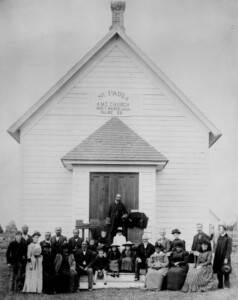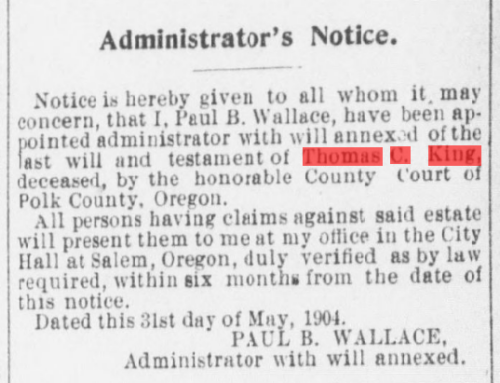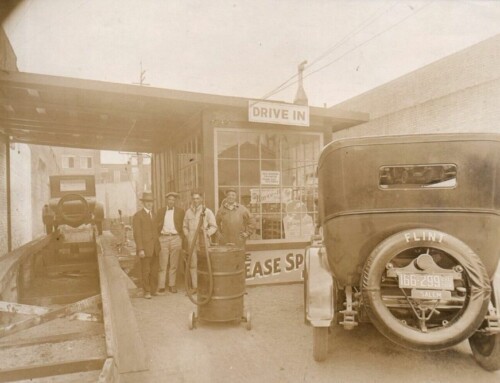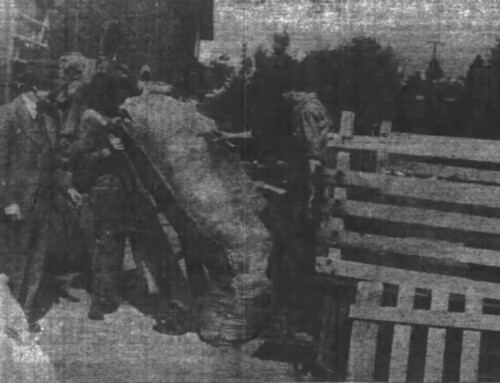
St. Paul’s A.M.E. Church, Salem, Oregon. Photo Source: State Library of Oregon reference number 2006.001.0705.
In my line of work, I have the opportunity to look at many historic photos of Salem. It can take a lot to surprise me, but I was glad when it happened last week while scrolling through the online photo collections at the State Library of Oregon. I stopped short, staring at a stunningly clear photograph of a simple wooden church building with a sign on top reading: “St. Paul’s A.M.E. Church built March 1892 Salme [sic.], OR.” On the porch of the church, standing above a multiracial congregation of well-dressed men, women, and children, stands a mustachioed Black man — the Bible in his hand and elbow resting against a pulpit suggesting his status as pastor and leader. How had I never seen this image before or heard the story of this man and this church? While newspaper accounts provide tantalizing clues for a better understanding of the church’s history, they also beg more questions.
See the original photograph. See catalog record at the State Library of Oregon.
Unpacking the Name
The abbreviation A.M.E. stands for African Methodist Episcopal Church, a denomination founded by African American leaders in Philadelphia in 1816, but with roots dating back to organizations and churches established in the late 1700s. While born out of connections to and doctrinally influenced by the Methodist church, the denomination was independent — created as a rejection of prejudice experienced by Black leaders and members once affiliated with it. The A.M.E. Church was the first independent Black protestant denomination founded in the U.S. and continues today with millions of members on five continents. [1]
Despite sharing many words in the titles, St. Paul’s A.M.E. Church was not in any way affiliated with St. Paul’s Episcopal Church, which confusingly operated in Salem during the same timeframe. The Pauline Memorial AME Zion Church in Salem today, founded in 1972,[2] while again similarly named belongs to a separate denomination – the African Methodist Episcopal Zion Church. There was an A.M.E. Zion Church planned for South Salem in the early part of the 20th Century, but that is a fascinating and lengthy story for another time.
“A New Church for Salem.”[3]
The Reverend G. W. White arrived in Salem in August, 1891[4] to start an A.M.E Church.[5] After a couple of afternoon meetings held at Salem’s First Methodist Church, the St. Paul’s African M.E. church was founded on September 2, 1891 with eight charter members.[6] Congregants held services at the German M.E. church,[7] while raising funds for their own building. Just a few months after Rev. White arrived, the congregation had raised $200 and purchased property.[8] On December 29, 1891 (at 4 pm in the afternoon) the deed for Lot 9, block 14 in the River Side Addition in North Salem was recorded at the Marion County Courthouse. It was signed and witnessed by church trustees H.B. Smith. R.C. Starkey, George T. Reynolds, William Gorman and E.H. Shepard.[9] The lot purchased corresponds today to the southern end of what are now the Susan Lee Apartments on east side of Liberty Street between the railroad tracks and River Street NE.[10]
The church building went up quickly. Planned to be 20 x 30 feet and cost between six hundred and seven hundred dollars, funding for the new church was raised throughout a large section of the Salem community. One listing of contributors included many well-known Salemites like George Whitaker (then president of Willamette University[11]), Z.F. Moody (former Oregon Governor[12]), and B.F. Drake (manager of the Salem Iron Works).[13] The building was finished by May 1892, less than a year after Rev. White had arrived to plant the church.[14] The Oregon Statesman editorialized that “Mr. White has worked hard during his stay of less than a year here, and has certainly accomplished much for so short a period.”[15]
The church services, advertised frequently in these early years, generally consisted of morning and evening services held at 11 am and 7 or 7:30 pm, each featuring messages from different scriptures. Sunday school was held at 1 pm.[16] Other community events memorialized in the newspaper record include the founding of an African M.E. Ladies Aide Society, which hosted a Thanksgiving feast fundraiser for the church in 1893 that raised over $25.00. A .25 cent a plate bought homecooked turkey, chicken, and sweet potatoes.[17]
Rev. White left his post as pastor in 1894. One article states he left to take up graduate studies in theology at Willamette University and another to serve as a missionary for the Puget Sound Conference of the A.M.E. Church.[18] After White’s departure, regular advertisements for services in the local newspapers drop off dramatically. The sporadic mentions that do appear include various guest speakers, but there is little evidence of a fulltime pastor until 1897, with a single mention of a “W.J. Bowerman, pastor.” E.P. Kyle is listed as pastor in 1903.[19]
By 1910, the church starts being listed on the Delinquent Tax List,[20] suggesting that it had stopped regular operations. A report by Ella McMunn of the Oregon Statesman in December 1911 noted that a woman had taken up residence in the church building.[21] By 1926, no buildings appear on the Sanborn Fire Insurance Map on the lot which the church had once occupied, suggesting the building had been razed.
The Mysterious Life of Rev. G.W. White
While we can track his time in Salem though his many newspaper appearances, the rest of his life story is mysterious. Where did Rev. White come from? This depends on which newspaper article you read. In one article he is “late of Seattle,”[22] in another from California.[23] As late as May 1891,[24] Rev. White appears to have been the pastor of the similarly named St. Paul’s A.M.E. Church in Spokane, a church which he planted in 1890 after reportedly coming from Portland.[25] At the founding of the Spokane church, it was written of him that: “Mr. White has been in the ministry a number of years, and for a long time he was stationed in San Francisco. He comes highly recommended as an eloquent speaker and an energetic church worker.”[26]
Tracing his pathway after he leaves Salem is even more difficult. It turns out there are many Rev. G.W. Whites. Is he the San Francisco-based pastor of the Central M.E. Church who spoke at a 1904 Chautauqua program in Oregon City, telling the story of the Haitian revolutionary hero François Toussaint?[27] Is he the Rev. G. W. White putting up a two-story building near the Globe Hotel in Sunnyside, Washington mentioned in the Yakima Herald in 1903?[28] Or the Rev. G.W. White who helped plan and host a patriotic meeting in Scandia, Iowa in 1917?[29] Without more clues, his fate remains a mystery.
All Are Welcome[30]
One of the wonderful and most frustrating parts of this image are the faces preserved in it. Photographs of Salem’s early African American community are few and far between. What a resource this would be had someone taken the time to identify the individuals in the photograph, perhaps a gentle reminder to us to label your photographs for future generations.
We do have a good idea of who was involved with the church. Charter members are listed in a newspaper announcement of the church’s founding as Albert and Mary Bayless, R.T. Starkey, Mrs. Jones, Mrs. H.E. Sheppard, George T. Reynolds and William Gorman.[31] Connecting names to faces is a little more elusive. Could the man in the center with the silvering hair be Albert Bayless, a charter member of the A.M.E. Church, who escaped slavery for the California gold fields before moving north to Salem and operating a blacksmith shop for nearly forty years. The man who one early Salem writer remembered as having hair “fast turning gray, and somewhere hidden about that old shop were sticks of red striped candy to give to the children who stopped to talk with him on their way from school.”[32] Without a verified date for the photo, can we even be sure that the pastor is Rev. G. W. White? There just isn’t enough data to help support identification.
“All are welcome,” was Rev. White’s tagline in early service announcements. While much of this photo remains a mystery, the story of the church and its pastor’s message of unity, reflected in practice through the faces of the individuals pictured, continues to inspire and be relevant as much today as when the photograph was taken. It remains a memento of hope, community, and fellowship.
This article was written by Kylie Pine for the Statesman Journal newspaper in February 2021. It is reproduced here with citations for reference purposes.
Citations
[1] Read More: African Methodist Episcopal Church: Our History: https://www.ame-church.com/our-church/our-history/. Wikipedia Article: https://en.wikipedia.org/wiki/African_Methodist_Episcopal_Church.
[2] Arends, Hank. “Land Allows Church to Grow.” Statesman Journal 23 Oct 1999 pg. 22.
[3] Headline for Oregon Statesman Article announcing foundation of church. See Oregon Statesman 04 Sept 1891 pg. 4.
[4] Earliest mention of White, which describes him as “Salem’s new colored minister” appears: “Colored Methodists.” Oregon Statesman. 28 Aug 1891 pg. 4.
[5] “Methodist.” Capital Journal. 29 Aug 1891 pg. 3 — just arrived in Salem to start and AME Church.
[6] “St.Paul’s AME Church.” Capital Journal 03 Sept 1891 pg. 3. “Last evening Rev. G.W. White…organized what will be known as St. Paul’s African M.E. Church.” This seems pretty specific; however, Oregon Statesman contradicts, suggesting that the church was “organized in this city on the 29th inst.” Suggesting a founding date of August 29, 1891. See “A New Church for Salem.” Oregon Statesman. 04 Sept 1891 pg. 4. A potentially syndicated article from the Albany Morning Daily Herald 04 Sept 1891 pg. 1. Suggests it was “organized here today” – supporting the September date. Similarly, article ““The New Church.” Capital Journal. 16 Apr 1892 pg. 3, give organizational date as September 2, 1891.
[7] Many instances to support his. See “Notes on Church Services.” Oregon Statesman 27 Sept 1891 pg. 4 as first instance of service announcement at German M.E. Church.
[8] Property purchased November 28, 1891 (date of instrument) – Not recorded until December 29, 1891. See Indirect Index to Marion County Deeds, 1891-1894, M-Z (digital page 173). https://www.familysearch.org/ark:/61903/3:1:33S7-9YQM-KLB?i=172&wc=M6YT-QP6%3A355789701&cc=2071970.
[9] See Marion County Deed Book, 48, page 342. Available online with free FamilySearch Account: https://www.familysearch.org/ark:/61903/3:1:33SQ-GY3R-S85P?i=347&wc=M6YR-DWG%3A355715001&cc=2071970
[10] See Marion County Assessor’s maps. Plat Map: River Side Addition to North Salem, 1883
https://secure.co.marion.or.us/weblink/DocView.aspx?id=4075882; Plat Map: River Side Addition 1889:
https://secure.co.marion.or.us/weblink/DocView.aspx?id=4075905
[11] “George Whitaker (Oregon Educator).” Wikipedia: https://en.wikipedia.org/wiki/George_Whitaker_(Oregon_educator)
[12] “Zenas Ferry Moody” Wikipedia. https://en.wikipedia.org/wiki/Zenas_Ferry_Moody
[13] “The African M.E. Church.” Oregon Statesman 11 March 1892 pg. 4.
[14] Newspaper promises in will be ready for 4th quarterly meeting the first Sunday in May. “The New Church.” Capital Journal. 16 Apr 1892 pg. 3. Announcements for church meetings “Today’s Programme in Pulpits.” Oregon Statesman. 29 May 1892 pg. 4. States services held 11 am and 7:30 pm at building in “North Salem.”
[15] “Going to Conference.” Weekly Oregon Statesman 12 Aug 1892 pg. 12.
[16] Many examples. See “St. Paul’s” Capital Journal 05 Aug 1893 pg. 4; “ST. Paul’s A.ME.” Oregon Statesman 27 Nov 1892 pg. 1.
[17] “Card of Thanks.” Capital Journal. 07 Dec 1893 pg. 4; “Thanksgiving Announcements.” Capital Journal 29 Nov 1893 pg. 4.; “Will Give Thanks.” Capital Journal 18 Nov 1893 pg. 4
[18] “Personal Mention.” Oregon Statesman 29 Jul 1894 pg. 5. “Rev. G.W. White. Formerly pastor of the African M.E. Church in Riverside addition to Salem but now missionary of the Puget Sound conference, is in this city.” “The African ME” Oregon Statesman 06 Jan 1894 pg. 14 “Rev. G.W. White, the first pastor, who is now undergoing a post graduate course in theology at Willamette University. The Pulpit is temporarily vacant.”
[19] African M.E. Oregon Statesman 02 Aug 1903 pg. 5.
[20] “Delinquent Tax List 1910.” Oregon Statesman 12 Aug 1911, pg. 2.
[21] McMunn, Ella. “Salem’s Poor are Suffering in Ranks of Unemployed. Oman. 20 Dec 1911 pg. 4. “Another widow lives in an old building that is boarded up because the window lights are broken out. It is dark and damp. Some of you know the place for it is the old colored church in North Salem.”
[22] “St. Paul’s AME CHURCH.” Capital Journal 03 Sept 1891 pg. 3.
[23] “Will Build” Capital Journal. 13 Feb 1892 pg. 3
[24] See St. Paul’s A.M.E. Church Spokane Chronicle. 02 May 1891 pg. 5
Church, corner third and Stevens streets…. A change of ministers – G.W. White is sent by the P.E. Rev. P.R. Green to the A.M.E. Church, Roslin…. Rev. G.W. White will preach his farewell sermon tomorrow night at 8 pm.
[25] “A New Church.” Spokane Daily Chronicle. 05 Sept 1890 pg. 8
[26] A New Church.” Spokane Daily Chronicle. 05 Sept 1890 pg. 8
[27] “Hobson Spoke.” Oregon Statesman 15 Jul 1904 pg. 1.
[28] “Sunnyside.” Yakima Herald. 15 Apr 1903 pb 10
[29] Article in the Des Moines Bystander 31 Aug 1917 pg. 1. Describes a Rev. G.W. White, pastor of the AME Zion Church (a different denomination from what he had been preaching in).
[30] Tag line included on most announcements for Rev. G.W. White’s services. See as example “Today’s Programme in Pulpits.” Oregon Statesman 13 Mar 1892 pg. 4.
[31] “St.Paul’s AME Church.” Capital Journal 03 Sept 1891 pg. 3. “Last evening Rev. G.W. White…organized what will be known as St. Paul’s African M.E. Church.
[32] Steeves, Sarah Hunt. Book of Remembrance of Marion County, Oregon Pioneers 1840-1860. Portland: Berncilff Press, 1927, pg. 316.








Leave A Comment